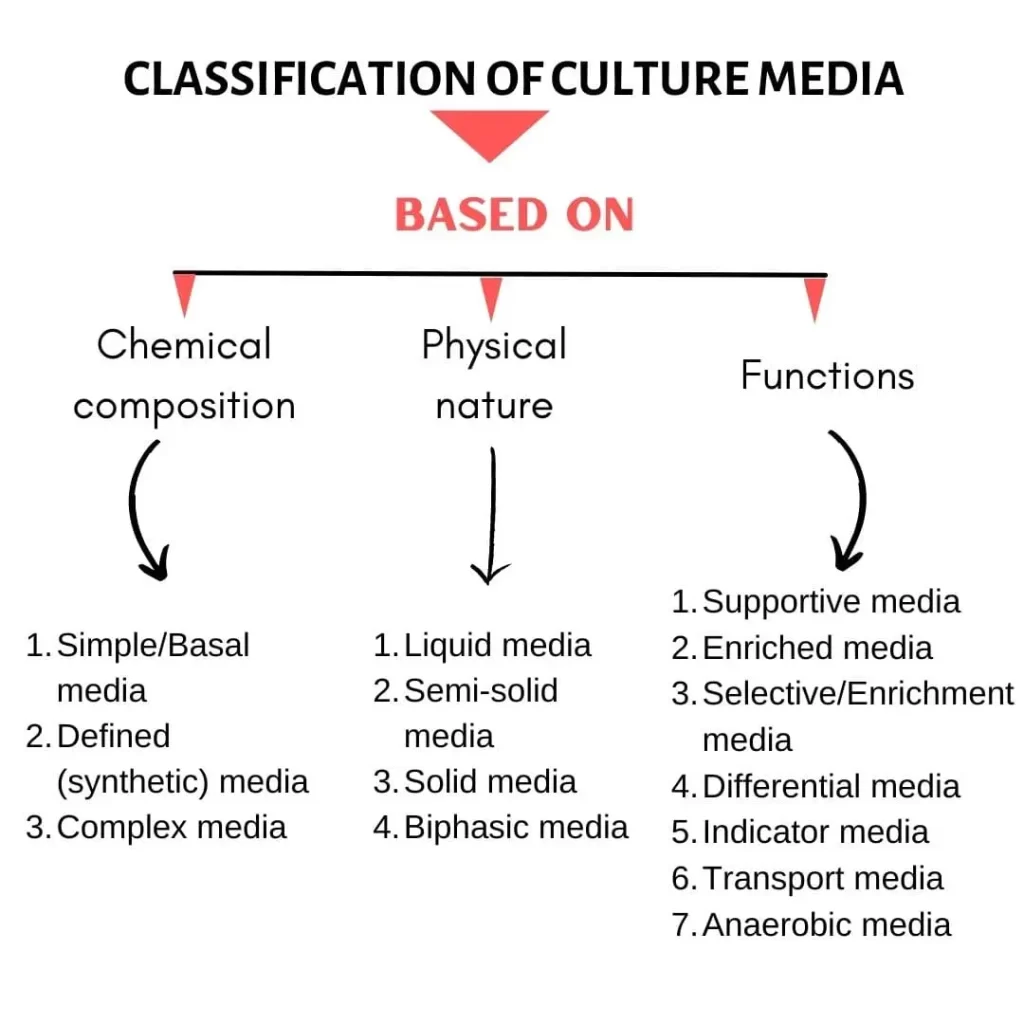
Table of Contents
ToggleHow Do You Study Something You Can’t See?
You place it under a microscope to observe, right?
But what if certain microorganisms, like bacteria, lack distinctive identifying features?
The answer: Grow them in large populations—a process known as culturing!
By observing their behavior under different conditions, scientists can unlock their secrets.
Introduction
To study microorganisms, we must first isolate them from their natural habitats and grow them in a controlled laboratory setting using synthetic culture media.
In this experiment, you will learn:
✅ The composition of culture media
✅ The types of culture media
✅ How different media help study bacterial properties
What is Culture Media?
A culture medium is a solid or liquid mixture of nutrients that supports microbial growth.
Why is it important?
🔹 It provides carbon and energy sources for bacterial growth.
🔹 It helps isolate and identify bacteria.
🔹 It aids in studying bacterial metabolism and properties.
🔹 It is essential for microbial storage and preservation.
Key Terms
📌 Inoculum – A suspension of microorganisms inserted into a culture medium.
📌 Inoculation – The process of introducing microbes into a culture medium.
📌 Culture – Microbes growing on a culture medium.
🔹 Pure culture – Contains only one species.
🔹 Mixed culture – Contains multiple species.
🔹 Contaminated culture – Contains unwanted microorganisms.
📌 Colony – A visible cluster of bacteria growing on solid media.
A Glimpse into History
📜 Louis Pasteur – Used simple broths made of urine and meat extracts.
📜 Robert Koch – First used solid media (potato slices) to grow bacteria.
📜 Gelatin – An early solidifying agent but had limitations:
❌ Melts at body temperature (37°C)
❌ Digestible by some bacteria
✅ The discovery of Agar as a solidifying agent revolutionized bacterial culture!
Characteristics of an Ideal Culture Medium
An ideal culture medium should:
✔ Support satisfactory growth even from a small inoculum.
✔ Promote rapid growth to yield results quickly.
✔ Be simple to prepare with minimal complexity.
✔ Be cost-effective and affordable for routine use.
✔ Be easily reproducible to ensure consistency in experiments.
Composition of Culture Media
A well-designed artificial culture medium must mimic the natural environment of microorganisms by providing all essential nutrients.
🔹 Key Components of Culture Media:
✅ Energy Source – Fuels microbial growth and metabolism.
✅ Carbon, Nitrogen, Sulfur, and Phosphorus – Essential building blocks for cellular functions.
✅ Minerals (Ca²⁺, Mg²⁺, Na⁺, Fe²⁺, etc.) – Maintain enzymatic activity and osmotic balance.
✅ Vitamins & Growth Factors – Support specialized microbial functions.
✅ Water – A fundamental requirement for microbial life.
- Water 🌊
- Absolutely essential for microbial growth.
- Must be free of contaminants that inhibit bacterial proliferation.
- Sodium Chloride & Other Electrolytes (K⁺, Mg²⁺, Fe²⁺, Ca²⁺) 🧂
- NaCl is a crucial component in most media.
- Sulphates serve as a source of sulfur.
- Phosphates provide necessary phosphorus for cellular processes.
- Peptone (Water-Soluble Protein Digest) 🥩
- Derived from enzymatic digestion of proteins.
- Supplies essential amino acids, carbohydrates, mineral salts, and polypeptides for bacterial growth.
- Meat & Yeast Extracts 🍖🍞
- Enriches media by providing protein degradation products, carbohydrates, inorganic salts, and growth factors.
- Supports the growth of fastidious organisms.
- Carbohydrates (Simple & Complex) 🍬
- Simple sugars (e.g., glucose, sucrose, maltose) provide instant energy.
- Complex carbohydrates (e.g., glycogen, glycerol) offer sustained energy release.
- Some carbohydrates help in differentiating bacteria based on fermentation ability.
- Agar (Solidifying Agent) 🌿
- A complex polysaccharide extracted from red marine algae.
- Acts as a solidifying agent for culture media.
- Most microbes cannot degrade agar, so it remains solid.
- Melting point: ~100°C
- Solidification temperature: ~40-45°C
Types of Growth Media
🔹 1. Cell Culture Media 🧬
- Used for the growth and maintenance of plant or animal-derived cells in vitro.
🔹 2. Microbiological Culture Media 🦠
- Supports the growth and preservation of bacteria, fungi, and yeast.
Classification of culture media

Culture media are classified into three main categories based on chemical composition, physical state, and functional properties.
Classification Based on Chemical Composition
1. Simple Media (Basal Media)
✔ Commonly used for routine laboratory diagnostics.
✔ Supports the growth of non-fastidious bacteria.
✔ Used for primary isolation of microorganisms.
✔ Examples: Peptone water, Nutrient broth, Nutrient agar.
2. Defined (Synthetic) Media
✔ Composed of precisely known chemical substances.
✔ Contains organic compounds that act as carbon and energy sources.
✔ Frequently used in research for studying microbial metabolism.
3. Complex Media
✔ Contains ingredients of unknown chemical composition.
✔ Essential for fastidious bacteria that have complex nutritional needs.
✔ Typically includes peptones, meat extracts, and yeast products.
✔ Examples: Nutrient broth, Tryptic soy broth, MacConkey agar.
Classification Based on Physical State
1. Liquid Media
✔ Does not contain solidifying agents.
✔ Used for inoculum preparation, especially when bacterial count is low.
✔ Supports large bacterial populations but does not allow differentiation.
✔ Bacteria grow uniformly, creating general turbidity.
✔ Example: Nutrient broth.
2. Semi-Solid Media
✔ Contains 0.5% agar, giving it a soft consistency.
✔ Used for determining bacterial motility.
✔ Helps distinguish motile from non-motile organisms.
3. Solid Media
✔ Contains solidifying agents (usually agar).
✔ Allows for isolation and differentiation of bacteria based on colony morphology.
✔ Helps observe pigmentation, hemolysis, and other characteristics.
✔ Examples: Nutrient agar, Blood agar.
4. Biphasic Media
✔ Contains both liquid and solid phases within a single container.
✔ The inoculum is first introduced into the liquid phase, then tilted to expose the solid phase for further subculturing.
✔ Solidifying agents like agar, egg yolk, or serum may be used.
Classification Based on Functional Properties
1. Supportive Media
✔ Provides basic nutrients to support the growth of a wide range of microorganisms.
✔ Examples: Tryptic soy broth, Tryptic soy agar.
2. Enriched Media
✔ Formed by adding blood, serum, egg yolk, or other nutrients to supportive media.
✔ Promotes the growth of fastidious bacteria.
✔ Examples: Blood agar, Chocolate agar, Loeffler’s serum slope.
3. Selective & Enrichment Media
✔ Selective Media: Encourages the growth of specific microorganisms while inhibiting others.
✔ Enrichment Media: Enhances the growth of a particular microorganism, often in liquid form.
✔ Examples:
- MacConkey agar (Selective for Gram-negative bacteria).
- Selenite F broth (Enrichment medium for Salmonella).
4. Differential Media
✔ Designed to distinguish between bacterial species based on metabolic activity.
✔ Contains indicators that produce visible changes in response to bacterial growth.
✔ Examples:
- MacConkey agar: Differentiates lactose fermenters (pink colonies) from non-fermenters.
- Blood agar: Acts as both an enriched and differential medium.
5. Transport Media
✔ Maintains microbial viability during specimen transport.
✔ Prevents drying out and controls the growth of unwanted bacteria.
✔ Examples: Stuart’s transport medium, Amie’s transport medium.
6. Indicator Media
✔ Changes color upon bacterial growth due to pH shifts or metabolic activity.
✔ Example: Wilson-Blair medium.
7. Anaerobic (Reducing) Media
✔ Supports the growth of anaerobic bacteria by maintaining a low oxygen environment.
✔ Often supplemented with special nutrients.
✔ Requires pre-use boiling to expel oxygen and sealing with sterile liquid paraffin.
Preparation of Culture Media
In microbiology laboratories, culture media are carefully prepared to support the growth of microorganisms.
The process involves several important steps:
- Measuring and Mixing – The required amount of dehydrated media is weighed accurately and dissolved evenly in distilled water. If needed, gentle heating is applied to help the powder dissolve completely.
- Adjusting pH – The pH level of the medium is adjusted to ensure it is suitable for the microorganisms being cultured.
- Sterilization – Most culture media are sterilized by autoclaving, which involves heating at 121°C for 15 minutes under high pressure (15 psi) to kill any unwanted microbes.
However, some ingredients cannot withstand high heat, such as:
- Glucose
- Antibiotics
- Urea
- Serum & Blood
These heat-sensitive components are sterilized separately using filtration and added to the medium after autoclaving to keep them effective.
Storage and Preservation
Once the culture media are prepared, they must be stored properly to maintain their quality and effectiveness:
✔ Solid and semi-solid media should be stored in the refrigerator at 4-5°C and can last for 1-2 weeks.
✔ Liquid media, if placed in screw-capped bottles, test tubes, or covered with cotton plugs, can be kept at room temperature for several weeks without contamination.
Reference Terminologies
- Broth – A liquid culture medium containing essential nutrients to grow microorganisms. It is also called nutrient broth. When agar is added, it becomes nutrient agar, but agar itself is not a nutrient—it only helps solidify the medium.
- Fastidious Bacteria – These are microorganisms that need special nutrients and multiple growth factors to survive. They are more delicate and require enriched media to grow properly.

Nice and helpful it is,,good job👍
Awesome!
Send me more about microbiology
It really helpful.please let me get it.
It’s really helpful and nice. It definitely will help us to know all about culture media and it’s related topic.Looking forward to getting this kinds of helpful topics…thank you so much.